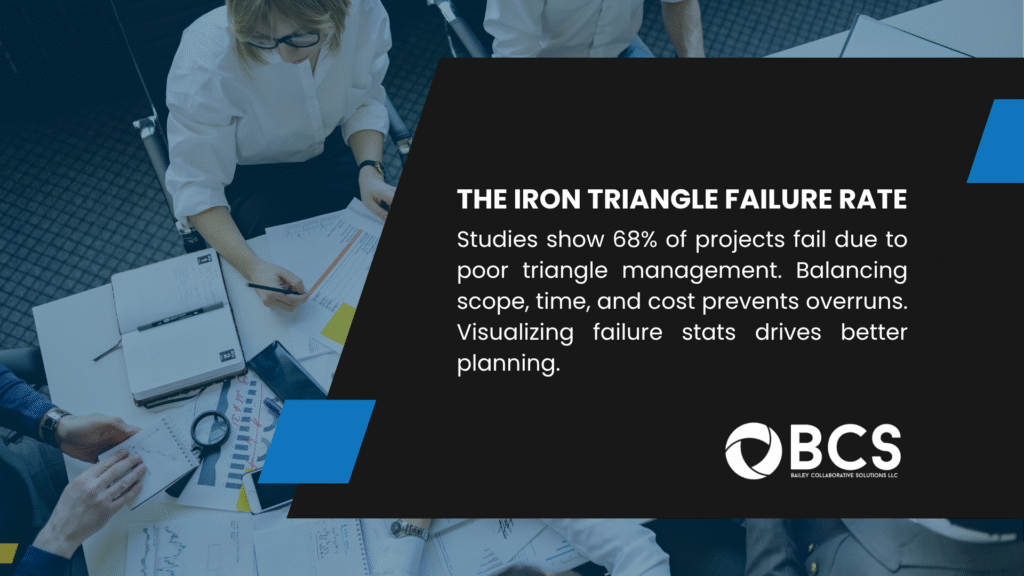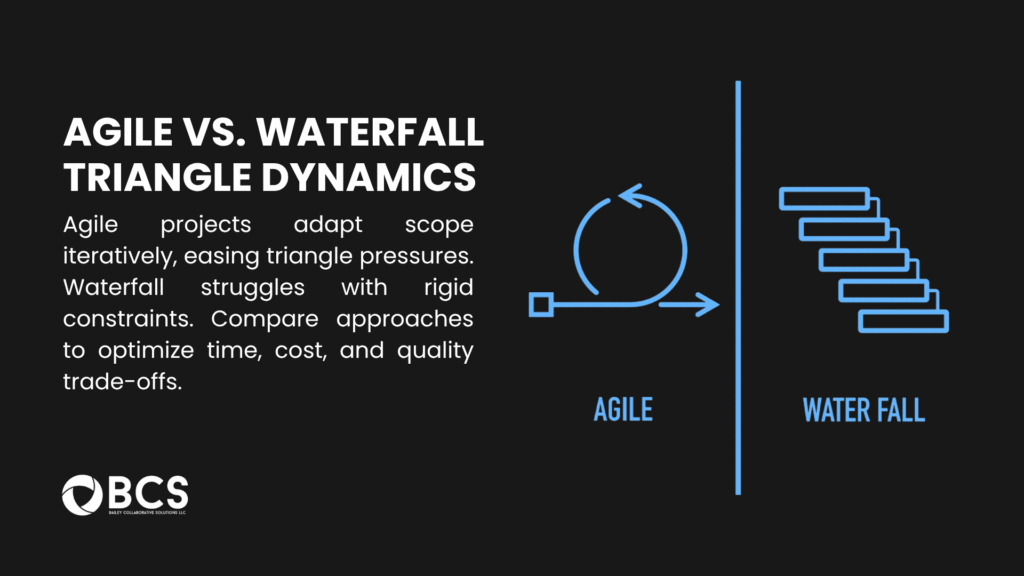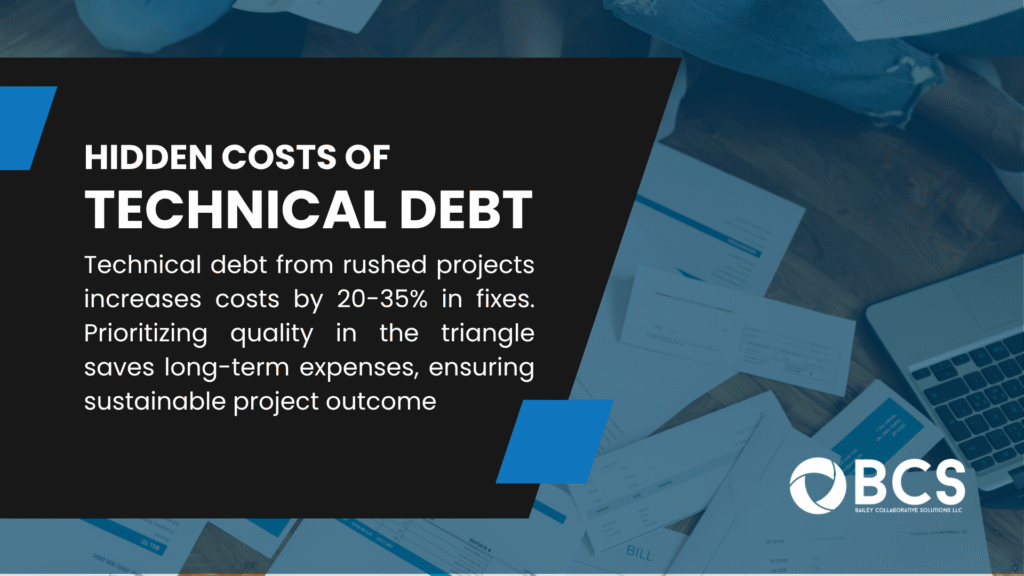Ask any project manager about their biggest headaches, and they’ll probably mention scope creep, impossible deadlines, or budget cuts. What they might not realize is that all three problems are connected through something called the project management triangle.
This triangle has been around forever, but it’s not some dusty academic concept. It’s actually pretty useful when projects start falling apart – which happens more often than anyone wants to admit. The basic idea is simple: scope, time, and cost are linked. Mess with one, and the others will shift too.
Most people think project management is about keeping everything on track, but experienced managers know better. Projects rarely go according to plan. The good managers figure out how to handle changes without everything exploding. That’s where understanding the project management triangle really pays off.
Companies working on system development life cycle projects see this constantly. Someone always wants to add features, speed up delivery, or cut costs. Usually all three at once, which is mathematically impossible but somehow expected anyway.
What Actually Makes Up the Project Management Triangle
Scope – The “What Are We Building” Part
Scope is everything the project is supposed to deliver. Sounds straightforward, but it gets messy fast. Take a mobile application development project. The scope might start as “build an app for ordering food.” Simple enough.
Then marketing wants push notifications. Sales want loyalty points. The CEO saw a competitor’s app and wants that feature too. Before anyone knows it, the simple food ordering app has become a full-blown restaurant management system.
The worst part? Nobody thinks these additions are a big deal. “It’s just one more button,” they say. But that button needs backend systems, database changes, testing, and documentation. What looked like a small scope change turns into weeks of extra work.
Teams using model-based systems engineering face similar challenges. System requirements seem solid on paper, but stakeholders keep finding edge cases and special situations that need handling. Each addition ripples through the entire system design.
Time – When Reality Meets Deadlines
Time constraints come in all shapes and sizes. There’s the big deadline everyone talks about, but also smaller milestones, dependency chains, and resource availability windows. Modern digital engineering tools help track these moving parts, but they can’t make time magically appear.
The 7 stages of the system development life cycle create their own timing challenges. Skip steps or rush through early phases, and problems show up later when fixing them costs way more time and money.
Real timing problems usually come from places nobody expected. Key team members get sick. Servers crash during critical testing. Third-party APIs change without warning. The timeline that looked reasonable in the planning meeting suddenly seems laughably optimistic.
Cost – More Than Just Money
Cost includes obvious things like salaries and software licenses, but also hidden expenses that catch teams off guard. A payment system architecture project might need specialized security audits or compliance certifications that weren’t in the original budget.
Opportunity costs matter too, though they’re harder to track. When the best developer spends three months on one project, other projects suffer. When teams rush to meet deadlines, they often create technical debt that costs more to fix later.
Mobile application architecture projects face interesting cost dynamics. Cloud services can scale expenses up or down based on usage, making budget planning tricky. Development tools and testing platforms add recurring costs that seem small individually but add up quickly.

How the Project Management Triangle Actually Works
Here’s the thing about the project management triangle – it’s not really about keeping everything perfectly balanced. It’s about understanding what happens when balance gets disrupted because it always does.
Smart project managers don’t try to prevent changes. They prepare for them. When stakeholders want to add features to a distributed system architecture project, good managers already know the implications and can present realistic options.
| What Changes | What Usually Happens | What Smart Managers Do |
| Scope increases | Timeline stretches, costs go up | Show the math, get approval for trade-offs |
| Timeline shrinks | Quality suffers, costs increase | Add resources or cut features, not corners |
| Budget gets cut | Scope shrinks, timeline extends | Prioritize ruthlessly, communicate clearly |
Managing the Triangle When Things Go Wrong
Talking to Stakeholders Without Losing Your Mind
Most project management triangle problems come from communication failures. Stakeholders make requests without understanding the implications. Project managers say “yes” without explaining the trade-offs. Then everyone acts surprised when the project runs into trouble.
The best approach is showing, not telling. When someone wants to add features to a system architecture diagram, pull up the project plan and walk through exactly what changes. Show the dependencies, the testing implications, the resource requirements.
Visual tools help enormously. Gantt charts, budget dashboards, and scope matrices make abstract concepts concrete. People understand pictures better than explanations, especially when they’re not project managers themselves.
Planning for Flexibility Instead of Perfection
Rigid plans break under pressure. Smart project managers build flexibility into their approach from the start. This doesn’t mean being sloppy – it means being realistic about how projects actually work.
Teams following software development life cycle phases often use iterative approaches that expect changes. Instead of trying to define everything upfront, they focus on delivering working pieces that stakeholders can evaluate and refine.
Buffer time and contingency budgets aren’t admissions of failure. They’re insurance policies against the unexpected problems that hit every project. The question isn’t whether something will go wrong – it’s whether the project can handle it when it does.
Using Risk Management to Stay Ahead
The project management triangle makes risk assessment easier. Instead of worrying about everything that could go wrong, focus on risks that could disrupt scope, time, or cost constraints.
Advanced modeling and simulation projects face technical risks that mostly affect the timeline. Market shifts might change scope requirements. Resource availability issues typically impact both time and cost.
Understanding these patterns helps teams prepare better responses. When technical risks are high, build extra time into the schedule. When market conditions are uncertain, keep the scope flexible. When key resources are limited, have backup plans ready.

Quality
The traditional project management triangle focuses on scope, time, and cost, but quality often acts as a hidden fourth constraint. Quality decisions affect all three main constraints and usually determine how trade-offs get resolved.
Digital quality engineering practices help teams maintain standards while managing triangle pressures. Building quality into the development process prevents quality issues from creating surprise impacts later.
Projects that sacrifice quality to meet other constraints often face bigger problems down the road. A system architecture space defense project that cuts testing to meet deadlines might deliver a system that fails when it’s needed most.
The smart approach is treating quality as a constraint rather than a nice-to-have. Define minimum acceptable quality levels upfront, then use those standards to evaluate scope, time, and cost trade-offs.
Mistakes That Make Everything Worse
The “Everything Is Critical” Trap
Some organizations declare that scope, time, and cost are all non-negotiable. This creates impossible situations for project managers who have no flexibility to handle changes or problems.
Successful projects identify which constraint has the most flexibility and use that knowledge to guide decisions. Maybe the deadline is firm because of regulatory requirements, but an additional budget is available. Or perhaps the budget is fixed, but some features could be deferred to later phases.
Ignoring the Ripple Effects
Teams sometimes approve changes without thinking through the implications. Adding a “simple” feature to a mobile application penetration testing project might require additional security reviews, documentation updates, and staff training.
Each change creates ripples that affect other parts of the project. Good change control processes trace these connections and help stakeholders understand the full impact of their requests.
Hoping Problems Will Fix Themselves
When projects start falling behind schedule or going over budget, some managers hope things will improve without intervention. This almost never works. Project management triangle problems tend to get worse over time, not better.
Early intervention usually provides more options and lower costs. Waiting until the last minute to address triangle imbalances often forces unpleasant choices between bad options.
How Technology Changes Triangle Management
Modern technology has shifted how teams handle project management triangle constraints. Cloud platforms and automated tools sometimes allow scope increases without proportional cost increases. Model-based systems engineering tools provide better visibility into project complexity and constraint relationships.
However, technology advantages only help teams that understand the underlying principles. Having better tools doesn’t prevent poor decision-making about scope, time, and cost trade-offs.
The most valuable technology improvements provide real-time visibility into constraint status. Dashboard systems that show scope completion, schedule adherence, and budget burn rates help teams spot problems early and make better decisions quickly.

Making Triangle Management Work for Real Projects
Understanding the project management triangle is just the beginning. Actually using it effectively requires experience, judgment, and often some hard-won wisdom about how projects really work.
Different types of projects present different triangle challenges. Engineering projects might have more rigid technical constraints. Creative projects often struggle with scope definition. Compliance-driven projects face inflexible deadlines.
The best project managers develop intuition about which constraints to focus on and when to push back on unrealistic expectations. They learn to spot the warning signs of triangle imbalance and know how to guide stakeholders toward realistic solutions.
But even experienced managers benefit from expert support, especially on complex or critical projects. When project success affects business outcomes, professional guidance often makes the difference between delivering results and explaining what went wrong.
Get Professional Help with Project Triangle Management
Managing the project management triangle sounds straightforward in theory, but real projects present complex challenges that require experience and expertise to handle effectively.
BCS brings deep expertise in project management fundamentals combined with advanced engineering capabilities and proven methodologies. The team understands how to navigate scope, time, and cost constraints while maintaining quality standards that demanding projects require. Don’t let poor triangle management derail important projects. Contact us to learn how professional project management expertise can help deliver results on schedule, within budget, and beyond expectations. When project success matters, experience makes all the difference.




